This post may contain affiliate links. Please read our disclosure for more info.
Woke up with a stiff neck? Everyone who has experienced this knows that it is no fun. Unfortunately, the feeling of discomfort can affect not just your physical body, but also your day and your mood.
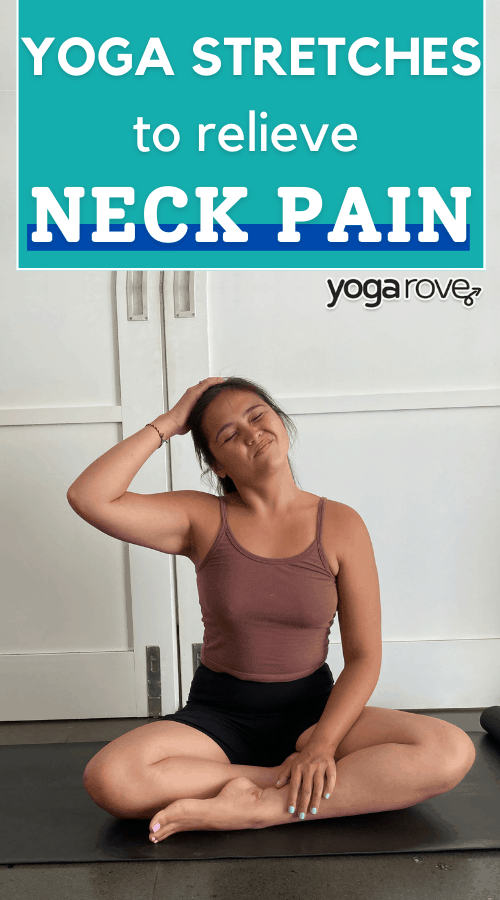
There’s nothing more annoying than not being able to move your neck properly as you go through your day! But did you know that there are certain yoga stretches that can relieve your neck pain?
What Causes My Neck Pain?
Neck pain can have many causes, some of which include:
- Muscle strain
- Poor posture
- Bad sleep posture
- Neck injuries
- Herniated disc
- Meningitis
- Osteoarthritis
Instead of keeping your body in one straight line when you’re reading, working on your laptop or at your desk, or looking at your smartphone, sometimes moving your head forward can create a strain on your neck. Or sometimes, neck strain is also the result of sleeping in a weird position for many hours. In all likelihood, your neck pain will disappear within a few days, but if you continue to experience discomfort, it’s always a good idea to visit your doctor.
Yoga Poses to Avoid When You Have Neck Pain
Depending on your body and your history, there may be certain yoga poses that may cause a strain in your neck when you practice them. For some, it might be poses that put direct pressure on the neck area, while for others, its poses that cause you to turn your head in one direction.
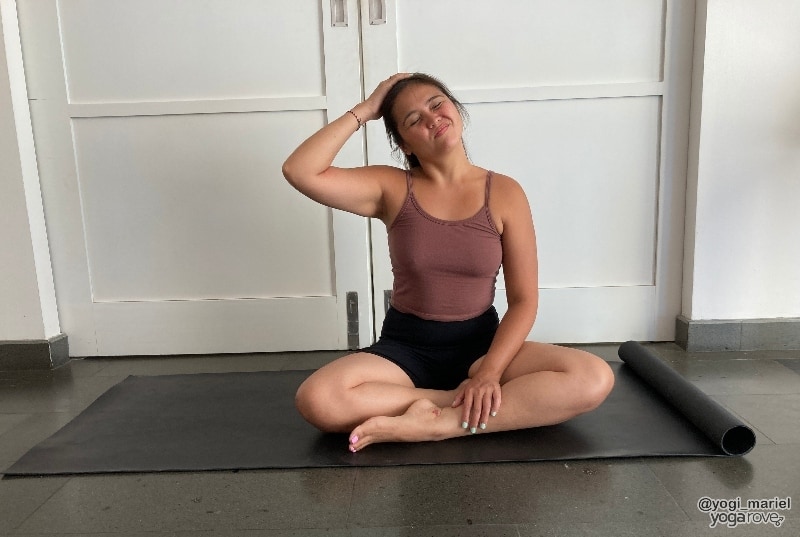
Generally, any posture that feels intense on your neck should either be avoided or modified. There are many modifications that you can take in certain poses that strain your neck, and if it more comfortable for you – take it! For example, when practicing Triangle pose, if it hurts to look up at your fingertips, keep your gaze down to your mat.
Here are some poses to take extra caution with if you have neck pain:
- Warrior 1: In this posture, your gaze should be directed toward your fingertips. For some yogis, this can put a strain on the neck, especially if they are working with any neck injuries. Instead of looking up, look straight forward and keep your neck straight.
- Triangle Pose: Just like Warrior 1, you are instructed to look up toward your fingertips in Triangle pose. Instead of looking up, look down toward your toes to avoid straining your neck.
- Chin Stand: Chin stand is a pretty advanced yoga pose in which you balance your body on your chin, hands, and chest. Needless to say, those with neck pain should try take caution when attempting this posture, or avoid it altogether.
- Shoulder Stand: A common cue in shoulder stand is to avoid moving your neck while you are in the posture. Keep your gaze steady, the back of your neck straight, and try not to move your head from side to side.
- Camel Pose: Instead of throwing your neck back and gazing towards the back of the room, keep your chest lifted and your hands supported at your lower back. Look up toward the ceiling and keep your chin slightly in toward your chest. This will allow you to have more support and practice a safer camel pose.
- Bow Pose: Similar to camel pose, bow pose is also a backbend that is usually taught by cuing the gaze to point up toward the ceiling. Instead of looking up, look forward and keep your chin level. Relax your shoulders and focus on the power of your legs to find a deeper backbend in your spine.
- Headstand: When practiced correctly, you should not feel a lot of weight on your head when practicing this inversion. However, even if there is no weight on your head, without proper instruction or alignment, headstand can be dangerous to practice if you have neck pain or neck injuries. Make sure that you practice with an experienced teacher, and take your time when learning this posture.
Yoga Poses to Relieve Neck Pain
Taking a few minutes a day to practice yoga can help to relieve your neck pain. Try out these yoga poses to release tension in your neck and shoulders.
Ragdoll Forward Fold
This posture is a great one to practice if you hold a lot of tension in your upper body, shoulders, and neck. The key here is to let everything be heavy and completely relaxed, and to keep your knees bending so that you feel the release in your upper body.
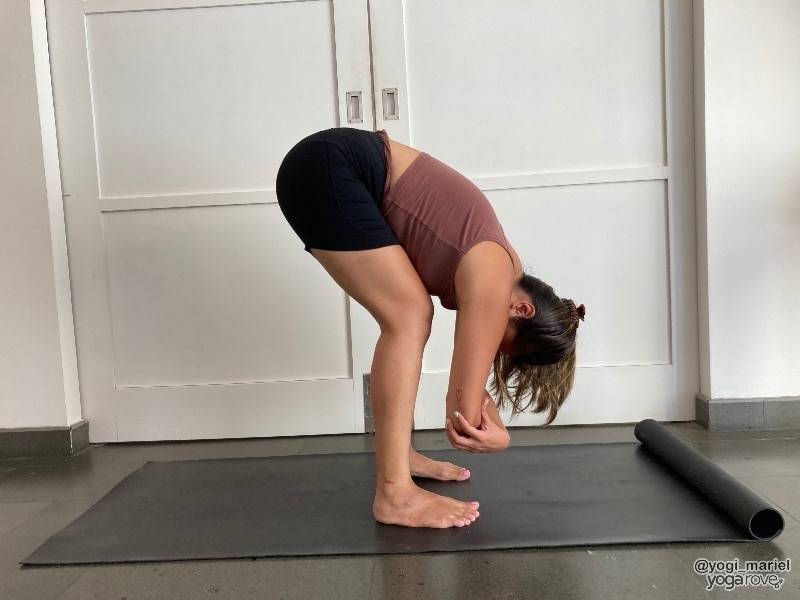
To practice Ragdoll:
- Start standing in Mountain pose with your feet hips width distance and your toes pointing straight forward.
- Bend your knees and slowly roll down, keeping your core engaged as you lower.
- Allow your fingertips to touch the floor or hold on to opposite elbows and gently swing from side to side to relax your spine.
- Move your head from left to right to release tension in the neck.
- Keep your knees bending with your stomach on your thighs and chest toward your knees.
- Take five breaths here and allow your entire upper body to relax.
Neck Rolls
A great exercise to do before your yoga practice, neck rolls can release tension in your shoulders and your neck. Be sure to move slowly and take your time to feel every part of your neck as you roll both directions.
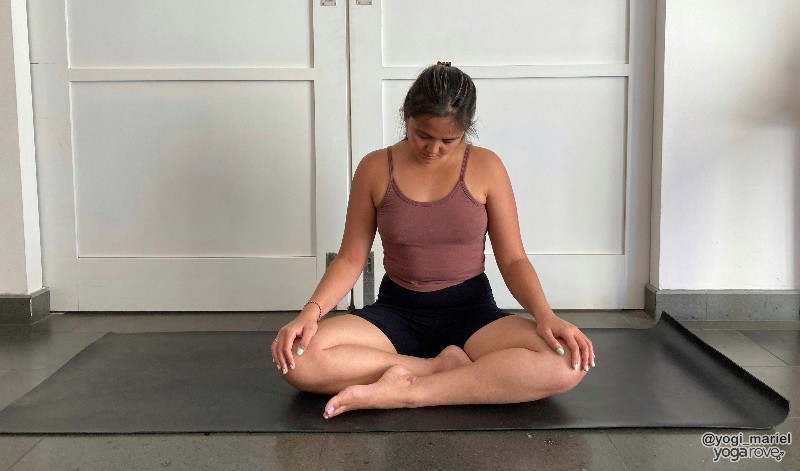
To practice Neck Rolls:
- Start in a comfortable seated position.
- Gently drop your right ear to your right shoulder.
- Slowly roll your neck in a clockwise position, closing your eyes if you would like.
- Repeat 3 times and do the same on your left side, rolling counterclockwise.
Neck Stretch
This stretch can feel quite intense so be sure to take your time and breathe deeply. Only go to as far as feels comfortable in your body and keep your shoulders relaxed as you stretch.
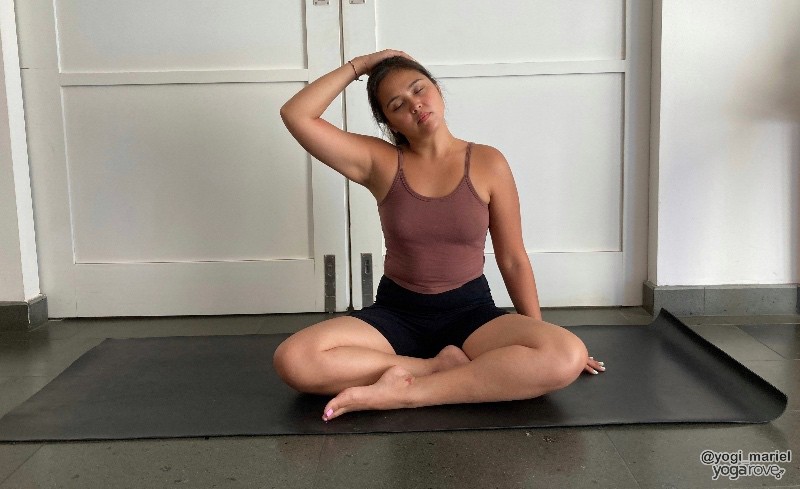
To practice a Neck Stretch:
- Start in a comfortable seat.
- Drop your right ear toward your right shoulder. Don’t worry about touching your ear to your shoulder– make sure that you are comfortable and relaxed.
- Place your right hand on your left ear to gently stretch the left side of your neck.
- You can use your hand to go a little deeper if it feels comfortable in your body.
- Stay for 5 deep breaths.
- Repeat on the left side.
Puppy Pose
This pose stretches your arms, shoulders, back, and neck and it feels amazing! Stay for as long as feels comfortable in your body and make sure to breathe slowly and deeply. You can even close your eyes and feel yourself moving deeper with every breath.
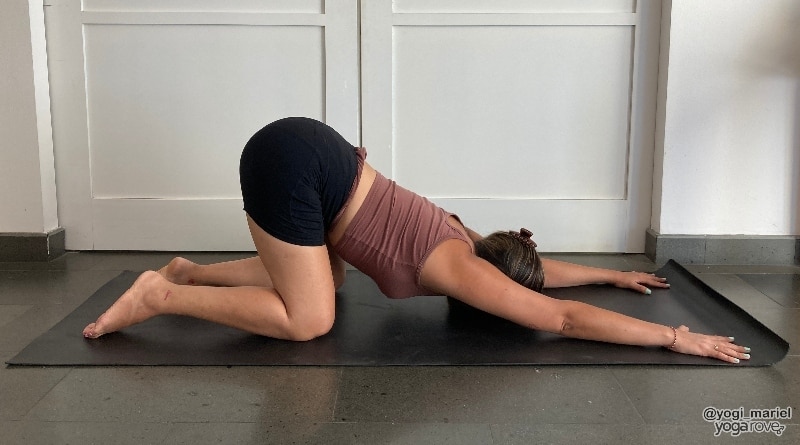
To practice Puppy Pose:
- Start in an all-fours position with your hands under your shoulders and your knees in line with your hips.
- Keep your hips as they are as your walk your hands forward to the top of your mat.
- Place your forehead down on your mat and stretch your arms forward as if you are in Downward Facing Dog.
- Spread your fingers wide, keep your palms flat on the floor, and your elbows off the mat. Y
- Relax your shoulders and think of your heart-melting down to the mat.
- Keep your hips above your knees and stay for at least 5 breaths.
Thread the Needle
Shoulder and Neck pain often go hand in hand, it is therefore also important to relieve tension in the shoulders. Thread the Needle is a great stretch for the shoulders and the neck and can be very relaxing. Stay for at least 5 deep breaths on each side.
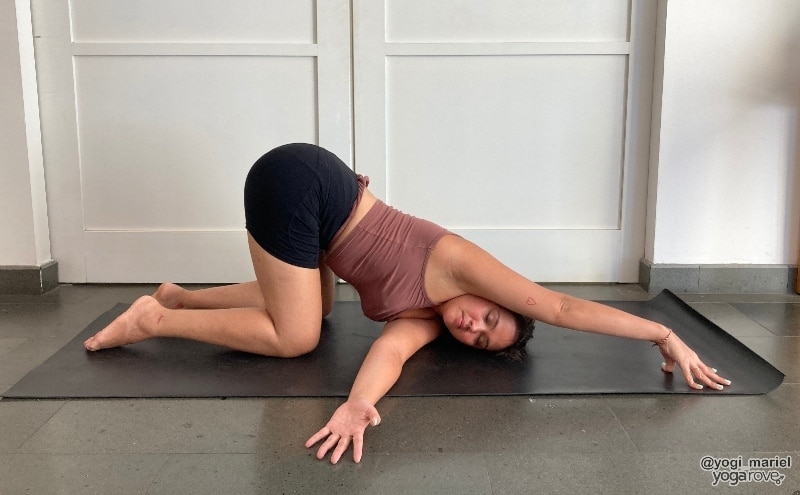
To practice Thread the Needle:
- Start on all fours with your hips under your knees and your hands under your shoulders.
- Inhale to lift the right arm to the sky and exhale to thread your right arm under your left shoulder
- If your right shoulder doesn’t touch the floor you can place a blanket or a block under it.
- Stretch the right arm to the left and place your right cheek or ear down on the mat.
- Keep your left palm on the mat for more support.
- Stay here for five breaths and repeat on the left side
Eagle Arms
Though it may not seem like much of a direct stretch for your neck, eagle arms are great for your shoulders and will loosen up your neck and shoulder area. You can modify this pose by reaching for opposite shoulders instead of interlacing your fingers together.
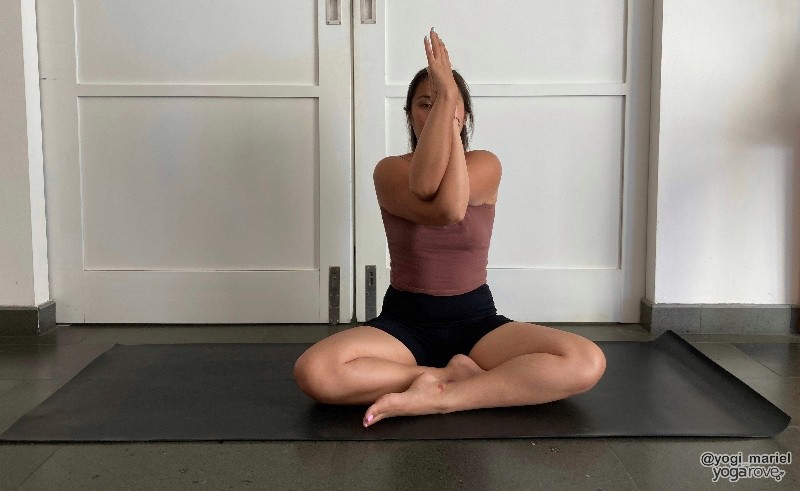
To practice Eagle Arms:
- You can take this pose seated or standing up.
- Inhale your arms up overhead and touch your palms together.
- Take your right arm underneath your left and cross once at the elbows and a second time at the wrists.
- If possible, interlace your fingers or press your palms together.
- Relax your shoulder and lift your elbows up.
- Move your elbows away from your body to feel the stretch.
- Stay for 5 deep breaths and repeat on the left side.
Seated Spinal Twist
This twist comes from your spine, not your neck. However, it can be a nice release in your upper body and can release tension in your neck as well. Be sure to feel the twist originate from your spine, instead of simply turning your head right or left. Practice this pose either seated on the floor or in a chair, if it is more comfortable.
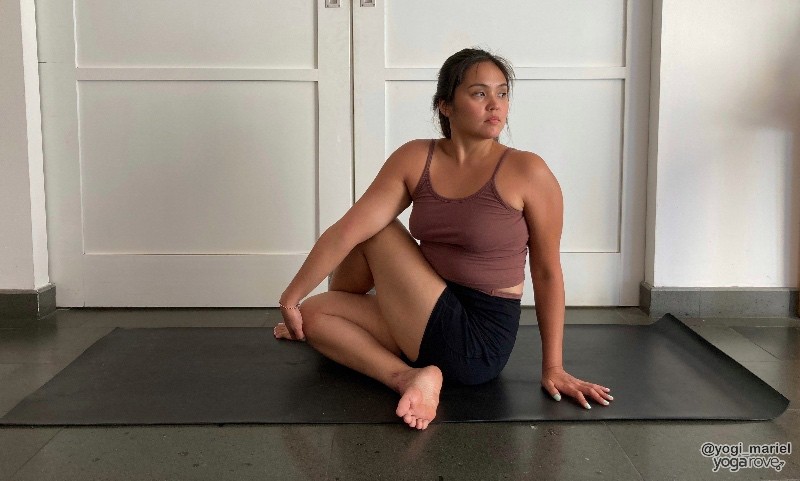
To practice Seated Spinal Twist:
- Start in a cross-legged seat, sitting on your knees, or sitting in a chair.
- Keep your spine straight and shoulders relaxed.
- Lift your right arm on an inhale and twist your body to the left on your exhale.
- Take your left hand behind your back and think of it as a second spine.
- Rest your right hand on your left knee.
- Gently turn your head and bring your chin toward your left shoulder. Move slowly.
- Stay for 5 deep breaths and repeat on the opposite side.
Supported Fish Pose
While an unsupported version of fish pose may strain your neck, practicing this posture with a modification be a great stretch for your neck. This version helps lengthen and relax the neck with the support of your yoga block or cushion.
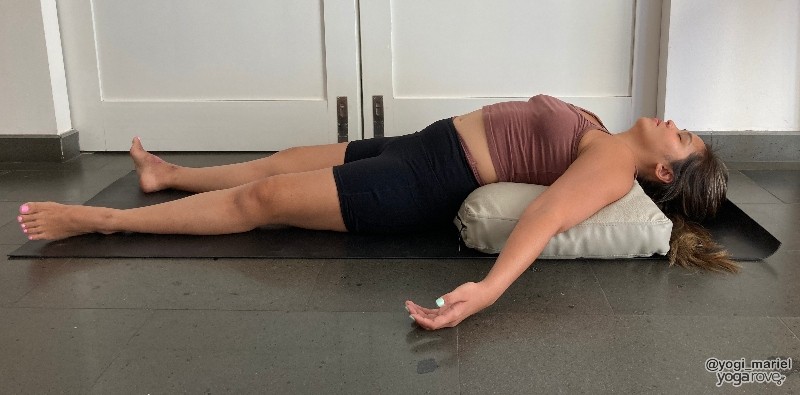
To practice Supported Fish Pose:
- Start by placing one block on the mat on the lowest height where your bra line would land if you were laying down in Savasana. You can also use a bolster or a cushion.
- Gently lay your body down and readjust your body or your block to ensure that your block or cushion is right underneath your chest.
- Relax your head down on the mat and keep your chest lifted with the support of your block
- If you need more head support, you can place another block, blanket, or pillow under your head.
- Stay for 8 breaths in the pose, or longer if you would like.
What Else Can I Do To Relieve Neck Pain?
In addition to practicing yoga poses to relieve your neck pain, there are a few other things that you can do to ease neck stiffness and tension. The important thing is to be gentle and mindful with your neck as you move, as your neck area is very sensitive. Sometimes the best remedy is to rest and give yourself a break, so be sure to listen to your body and give yourself what you need. Here are a few practices to add when dealing with neck pain:
- Gently stretch your neck: Gently is the keyword here. Try to avoid intense stretches to your neck, and move very carefully and gently. You can start by taking your right ear toward your shoulder, holding for a few breaths, and then repeating on the left side. Take a few, gentle neck rolls counterclockwise and clockwise. Move mindfully.
- Use ice and heat: Use an ice pack or heating pad for your neck to ease the pain and loosen the are up. It’s usually a good idea to apply ice for the first day or so, and then heat for the subsequent days.
- Rest your body: Take a break from your fitness routine and give your body some time to rest and recover. Let your muscles relax and enjoy a day or two of rest.
- Try not to slouch: Poor posture can exacerbate your neck pain so be aware of how you are holding yourself up. If you are at a desk all day, find a supportive seat and back and take breaks to stretch.
- Massage: A gentle self-massage can feel great but again, be mindful and gentle as you do this. You can use essential oils or Tiger Balms as you slowly massage your neck area and release any tightness and tension.
- Take a break from your computer and other gadgets: Looking down at your phone or staring into your computer all day can add tension to neck and shoulders. Take a little break from gadgets and computers if you can, or lessen your time on them.
How Can I Avoid Neck Pain?
Want to avoid neck pain altogether? There are many healthy habits that you can add to your daily routine to avoid neck pain. These small daily changes can help you to dodge that pesky neck pain:
- Check your pillows: Too many pillows? Not enough support? You spend a good amount of your day in bed, so it’s crucial that your body and your neck have the proper support and healthy pillows. Look into finding special pillows that support your neck and cervical spine.
- Be aware of your sleeping position: Try to avoid sleeping on your stomach, as it arches your back and turns your neck to the side. Ideal sleeping positions don’t require your neck to turn to one side, so sleeping on your back or on one side is best.
- Use a headset: Avoid tilting your head to one side or “squeezing” your phone in between your head and your shoulder by using Bluetooth headphones or regular headphones when you are on the phone. This is especially useful if you often have long phone calls.
- Pay attention to your posture: Try to be aware of your posture when you’re working, sitting down, or walking. Make sure that your spine is long, shoulders are relaxed, and your chest is lifted.
- Use neck-friendly bags: Try using a backpack instead of a shoulder bag. Usually, we can have the tendency to always carry our bags on the same side. Your body tries to compensate, creating tension in the neck.
- Adjust the height of your electronic devices: If you spend a lot of time in front of your computer, laptop, or tablet, try adjusting your monitor to eye level to avoid neck strain. At the same time, try not to spend too much time on your gadgets, as it can cause neck pain and tension.
Related questions
Does yoga relieve muscle tension? Yes – a few benefits of yoga include helping you to relax, lengthening muscles and reducing stress and tension. Stress can be a factor that can lead to muscle tension, so by practicing yoga, you can relax your muscles.
Is yoga good for neck problems? Yoga can help to relieve pain and you can follow a sequence that is focused on relieving neck pain and tightness. Look for specialized classes online. or ask your yoga teacher about specific poses that can help your neck problems.
Can yoga relieve headaches? Headaches are usually tension and stress-related and yoga is known to help with both. Focus on poses that help blood circulation like Shoulderstand, Legs up the Wall, and Forward Folds. Remember to take deep breaths to send more oxygen to the brain.


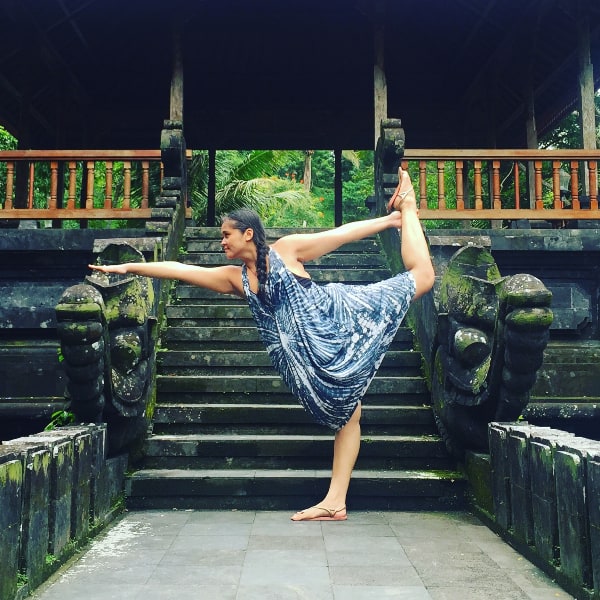

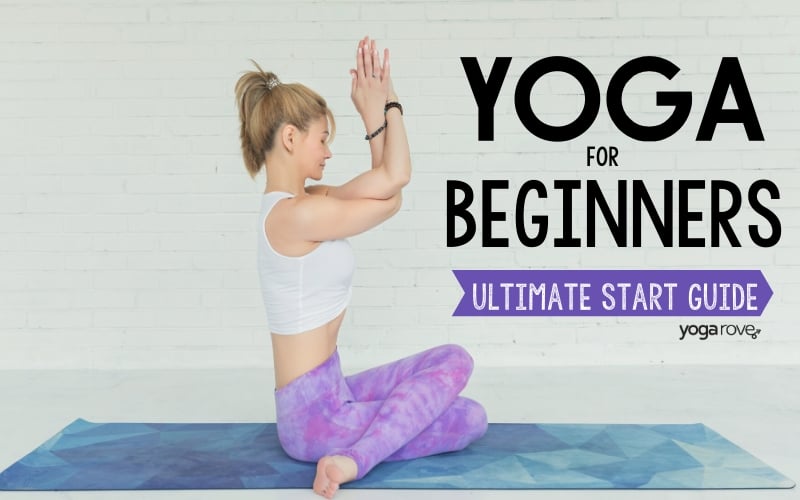


Extremely helpful article. Well done!!!!!!!!!
Happy you found it helpful Jaspal!
Hi, I would like to say that I’m looking forward to practicing these moves to aide with my neck discomfort. Also, I believe there may be an error on the instructions for the neck stretch, third bullet point. Shouldn’t it be your right hand to your left ear to stretch the left side of the neck?
Sincerely,
Mercedes
Thank you Mercedes! All fixed now 🙂
thanks just what I needed
Glad you enjoyed it Pam!
Great information
Namaste
Glad you found it helpful Saiyo!
For neck stretch you said to place right hand on right ear to gently stretch left side of neck. I think it should be right hand on left ear. Great info here. Recently I have had some left side neck pain and lack of mobility there. These poses will definitely help, thanks.
Thanks for catching that Mark! And glad you found it helpful 🙂